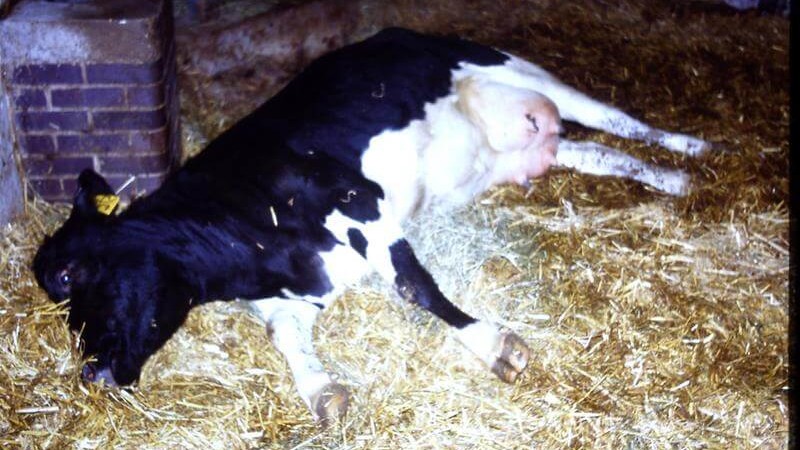

At the beginning of lactation high yielding cows experience a sudden rise in demand for calcium to replace the large amount lost through milk. This may result in great decrease in blood calcium if the cow is not able to replenish the calcium fast enough, causing a disease called milk fever.
The majority of milk fever cases occur within 48 to 72 hours of calving when demand for calcium for milk production exceeds the body’s ability to mobilize calcium reserves. Fever is a misnomer as body temperature is usually below normal.
Low blood calcium interferes with muscle function throughout the body causing general weakness, loss of appetite and eventually heart failure.
About 80% of cases occur within one day of calving because milk and colostrum production drain calcium (and other substances) from the blood, and some cows are unable to replace the calcium quickly enough. High producers are more susceptible because the fall in their blood calcium level is greater. Selecting cows for high production may, therefore increase the problem with milk fever. Some individual cow families or breeds (for example, Jerseys) are more susceptible than others.
Age is important. Heifers are rarely affected. Old cows increase in susceptibility up to the fifth or six calving because they produce more milk and are less able to replace blood calcium quickly.
The feeding management of dry cows in the 2 weeks before calving is very important, because it affects both the amount of calcium available to replace blood calcium and the efficiency with which the available calcium can be used.
When the amount of calcium in the diet is greater than is needed, the efficiency of absorbing calcium from the intestine and the efficiency of transferring calcium from the skeleton both become very sluggish and the chance of milk fever is greatly increased.
Fat cows are at a greater risk than thin cows. This is partly because their feed and calcium intake has been higher and partly because fat cows produce more milk at calving time.
Some cows get milk fever several days or even weeks before or after calving. This is usually due to the feed, especially the dietary calcium, being insufficient to meet the heavy demand due to the rapidly growing foetus or milk production in early lactation.
In early lactation, cows should receive as much calcium as possible, and clover-dominant pasture are therefore desirable. They will help to prevent grass tetany as well as milk fever.
Signs of Milk Fever
At first, cow experiences muscle tremors, lack of appetite, and unsteadiness.
Eventually, cow is unable to rise, body temperature falls, and constipation occurs. Cows go down to a sitting position often with a kink in her neck. Death can occur if the cow is not treated promptly.
Prevention
Management of the diet can be a valuable aid preventing milk fever. Cows should be kept on a low calcium diet while they are lactating (dry). This stimulates their calcium regulatory system to keep the blood levels normal by mobilising the body stores of calcium from the bone. When the demand for calcium increases as calving, calcium can be mobilised much more rapidly from bone than the feed, therefore preventing milk fever.
If it is necessary to improve the body condition of cows in order to improve milking performance, feeds high in energy but low in calcium may be used, for example cereal grain or hay. Cereal grain is also high in phosphorus content, and this is of additional value.
Cows close to calving should be kept in a handy paddock to enable frequent observation and early detection of milk fever. On the point of calving, and afterwards, the available feed and calcium should be unrestricted. Calcium feed supplements may be helpful at this point, but should not be given earlier.
Where dietary management is inadequate, other methods are sometimes used. Vitamin D3 given by injection 2-8 days before calving may be useful. As the calving date is often difficult to predict, repeated treatments are sometimes necessary.
High risk cows can be injected with Vitamin D3 2-8 days prior to calving. Some cows are given more than one treatment. This is quite successful because the calcium provides a reservoir to increase blood calcium just at the time it is needed for milk and colostrum. The danger is that it may not last long enough and milk fever may still occur before the calcium-regulating mechanism of the cow is working efficiently.
Diets providing less than 15gcalcium/cow/day and fed for at least 10 days before calving will reduce the incidence of milk fever.
 Contact Jaguza Support
Contact Jaguza Support